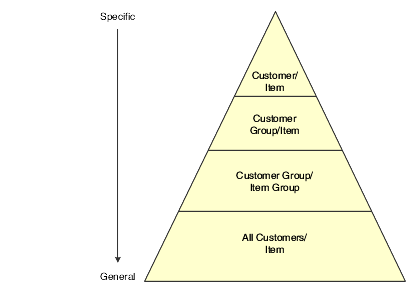Understanding the Base Price Preference Hierarchy
When the system retrieves the base price, it uses the hierarchy that you set up for the Base Price Preference (51) to determine the search sequence for base price records. The base price hierarchy is a matrix comprised of combinations of customers and items, and customer groups and item price groups. You use the intersection of the rows and columns to determine hierarchy sequence.
You should set up the pricing hierarchy from most specific to most general.
This diagram illustrates the price preference hierarchy from the most specific to most general:

During sales order entry, the system searches the combinations based on the hierarchy that you have defined. For example:
Item and customer.
Item and customer group.
Item group and customer.
Item group and customer group.
Item group only.
Item only.
Note: In Base Pricing, it is possible to enter as many as 14 numbers in the pricing hierarchy. However, you should limit the pricing hierarchy to three or four numbers, because each number represents a search by the system through the Item Base Price File (F4106) table. Therefore, each number that you add to the pricing hierarchy increases system processing time.